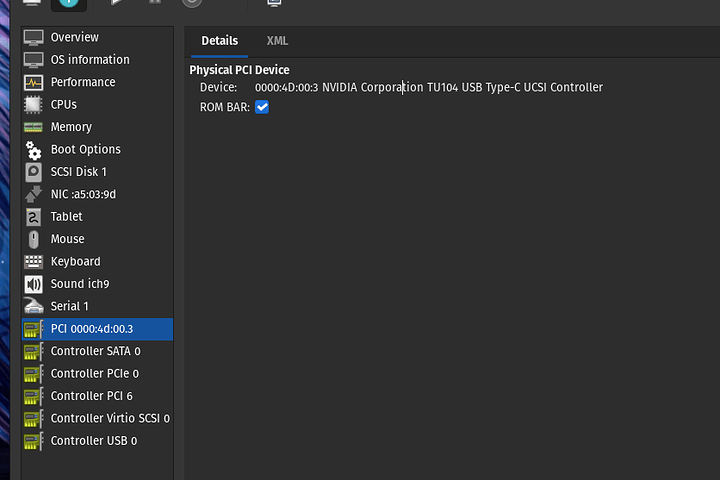I’ve been trying (un-sucessfully) to pass through a GPU to a Windows 7 VM.
I’ve got the VM setup, OS installed, bound the pci-ids, and then added the card to the VM (and removed the spice/qxl) but it won’t finish booting the VM with the GPU passed to it. I get output on the passed through GPU, windows boot screen, then It hangs on the “starting windows” screen and the logo looks like it is still “breathing”. Booting to safe mode it will hang on classpnp.sys.
virt-manager XML for VM
<name>Windows_7</name>
<uuid>e1311aba-f482-4524-987d-7fe0fae16aa6</uuid>
<metadata>
<libosinfo:libosinfo xmlns:libosinfo="http://libosinfo.org/xmlns/libvirt/domain/1.0">
<libosinfo:os id="http://microsoft.com/win/7"/>
</libosinfo:libosinfo>
</metadata>
<memory unit="KiB">16777216</memory>
<currentMemory unit="KiB">16777216</currentMemory>
<vcpu placement="static">8</vcpu>
<os>
<type arch="x86_64" machine="pc-q35-4.2">hvm</type>
<loader readonly="yes" type="pflash">/usr/share/OVMF/OVMF_CODE.fd</loader>
<nvram>/var/lib/libvirt/qemu/nvram/Windows_7_VARS.fd</nvram>
<bootmenu enable="yes"/>
</os>
<features>
<acpi/>
<apic/>
<kvm>
<hidden state="on"/>
</kvm>
<vmport state="off"/>
</features>
<cpu mode="custom" match="exact" check="partial">
<model fallback="allow">EPYC</model>
<topology sockets="1" cores="4" threads="2"/>
<feature policy="disable" name="hypervisor"/>
</cpu>
<clock offset="localtime">
<timer name="rtc" tickpolicy="catchup"/>
<timer name="pit" tickpolicy="delay"/>
<timer name="hpet" present="no"/>
<timer name="hypervclock" present="yes"/>
</clock>
<on_poweroff>destroy</on_poweroff>
<on_reboot>restart</on_reboot>
<on_crash>destroy</on_crash>
<pm>
<suspend-to-mem enabled="no"/>
<suspend-to-disk enabled="no"/>
</pm>
<devices>
<emulator>/usr/bin/qemu-system-x86_64</emulator>
<disk type="file" device="disk">
<driver name="qemu" type="qcow2"/>
<source file="/home/user/user-vm/Windows_7.qcow2"/>
<target dev="sda" bus="scsi"/>
<boot order="1"/>
<address type="drive" controller="0" bus="0" target="0" unit="0"/>
</disk>
<disk type="file" device="cdrom">
<driver name="qemu" type="raw"/>
<target dev="sdb" bus="sata"/>
<readonly/>
<boot order="2"/>
<address type="drive" controller="0" bus="0" target="0" unit="1"/>
</disk>
<disk type="file" device="cdrom">
<driver name="qemu" type="raw"/>
<target dev="sdc" bus="sata"/>
<readonly/>
<address type="drive" controller="0" bus="0" target="0" unit="2"/>
</disk>
<controller type="usb" index="0" model="ich9-ehci1">
<address type="pci" domain="0x0000" bus="0x00" slot="0x1d" function="0x7"/>
</controller>
<controller type="usb" index="0" model="ich9-uhci1">
<master startport="0"/>
<address type="pci" domain="0x0000" bus="0x00" slot="0x1d" function="0x0" multifunction="on"/>
</controller>
<controller type="usb" index="0" model="ich9-uhci2">
<master startport="2"/>
<address type="pci" domain="0x0000" bus="0x00" slot="0x1d" function="0x1"/>
</controller>
<controller type="usb" index="0" model="ich9-uhci3">
<master startport="4"/>
<address type="pci" domain="0x0000" bus="0x00" slot="0x1d" function="0x2"/>
</controller>
<controller type="sata" index="0">
<address type="pci" domain="0x0000" bus="0x00" slot="0x1f" function="0x2"/>
</controller>
<controller type="pci" index="0" model="pcie-root"/>
<controller type="pci" index="1" model="pcie-root-port">
<model name="pcie-root-port"/>
<target chassis="1" port="0x10"/>
<address type="pci" domain="0x0000" bus="0x00" slot="0x02" function="0x0" multifunction="on"/>
</controller>
<controller type="pci" index="2" model="pcie-root-port">
<model name="pcie-root-port"/>
<target chassis="2" port="0x11"/>
<address type="pci" domain="0x0000" bus="0x00" slot="0x02" function="0x1"/>
</controller>
<controller type="pci" index="3" model="pcie-root-port">
<model name="pcie-root-port"/>
<target chassis="3" port="0x12"/>
<address type="pci" domain="0x0000" bus="0x00" slot="0x02" function="0x2"/>
</controller>
<controller type="pci" index="4" model="pcie-root-port">
<model name="pcie-root-port"/>
<target chassis="4" port="0x13"/>
<address type="pci" domain="0x0000" bus="0x00" slot="0x02" function="0x3"/>
</controller>
<controller type="pci" index="5" model="pcie-root-port">
<model name="pcie-root-port"/>
<target chassis="5" port="0x14"/>
<address type="pci" domain="0x0000" bus="0x00" slot="0x02" function="0x4"/>
</controller>
<controller type="pci" index="6" model="pcie-to-pci-bridge">
<model name="pcie-pci-bridge"/>
<address type="pci" domain="0x0000" bus="0x04" slot="0x00" function="0x0"/>
</controller>
<controller type="pci" index="7" model="pcie-root-port">
<model name="pcie-root-port"/>
<target chassis="7" port="0x15"/>
<address type="pci" domain="0x0000" bus="0x00" slot="0x02" function="0x5"/>
</controller>
<controller type="pci" index="8" model="pcie-root-port">
<model name="pcie-root-port"/>
<target chassis="8" port="0x16"/>
<address type="pci" domain="0x0000" bus="0x00" slot="0x02" function="0x6"/>
</controller>
<controller type="virtio-serial" index="0">
<address type="pci" domain="0x0000" bus="0x02" slot="0x00" function="0x0"/>
</controller>
<controller type="scsi" index="0" model="virtio-scsi">
<address type="pci" domain="0x0000" bus="0x05" slot="0x00" function="0x0"/>
</controller>
<interface type="direct">
<mac address="52:54:00:a5:03:9d"/>
<source dev="enp68s0" mode="bridge"/>
<model type="virtio"/>
<address type="pci" domain="0x0000" bus="0x01" slot="0x00" function="0x0"/>
</interface>
<serial type="pty">
<target type="isa-serial" port="0">
<model name="isa-serial"/>
</target>
</serial>
<console type="pty">
<target type="serial" port="0"/>
</console>
<input type="tablet" bus="usb">
<address type="usb" bus="0" port="1"/>
</input>
<input type="mouse" bus="ps2"/>
<input type="keyboard" bus="ps2"/>
<sound model="ich9">
<address type="pci" domain="0x0000" bus="0x00" slot="0x1b" function="0x0"/>
</sound>
<hostdev mode="subsystem" type="pci" managed="yes">
<source>
<address domain="0x0000" bus="0x4c" slot="0x00" function="0x0"/>
</source>
<address type="pci" domain="0x0000" bus="0x07" slot="0x00" function="0x0"/>
</hostdev>
<hostdev mode="subsystem" type="pci" managed="yes">
<source>
<address domain="0x0000" bus="0x4c" slot="0x00" function="0x1"/>
</source>
<address type="pci" domain="0x0000" bus="0x08" slot="0x00" function="0x0"/>
</hostdev>
<memballoon model="virtio">
<address type="pci" domain="0x0000" bus="0x03" slot="0x00" function="0x0"/>
</memballoon>
</devices>
</domain>
I’ve set the KVM hidden state to avoid the “Code 43” on nividia cards.
I set the hypervisor feature policy disabled so that I can boot with more than 1 core with windows 7.
I tried to run this modified OVMF firmware (from linked thread), but it tries to run startup repair and then I get a bunch of errors I don’t understand.
I tried switching to seabios and I couldn’t get it to recognize the disk image (virtscsi).
The VM works fine with QXL/Spice, but alas I want atleast a little 3d acceleration.
System Details
Hardware
- 3970X
- Asus Zenith II Extreme Alpha
- Asus 2080ti (used for host)
- Zotac GT710 (pcie x1 version, used for guest)
Software
- Pop OS 20.04 (up to date)
- Kernel: 5.4.0-7642-generic
- virt-manager 2.2.1
- QEMU emulator version 4.2.1 (Debian 1:4.2-3ubuntu6.6)
I’ve searched all over the internet and most of the information I can find on using Windows 7 for passthough is outdated. It seems most people use Windows 10 for passthough, but I’m trying to use old software that won’t like Windows 10 (hence the VM).
Anybody have any Ideas?
-Chuck
